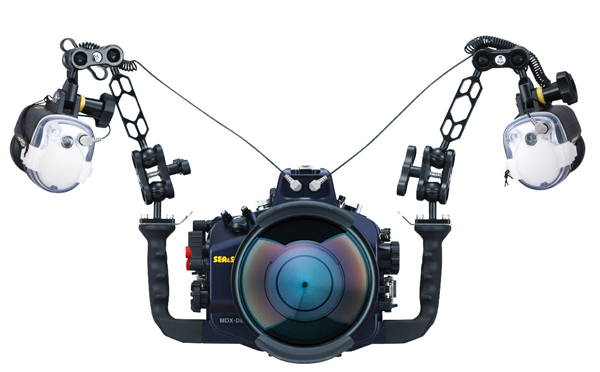by underwater photographer Magnus Lundgren
So why a page like this?
Many travellers feel uneasy when packing for their UW photography trip. You do not want to forget any vital gear and at the same time minimize the luggage. It is sometimes ridiculous when we travel to the other side of the world with so much equipment and we can still only fit in five pairs of underwear. So the packing for a trip is all about bringing everything you need and nothing else.
The time we spend on dive trips are unfortunately limited so when we are out there we can't accept a stand still photography wise. So to make sure you bring all items and have a reasonable redundancy on location use this list a reference. The packlist below is a general recommendation and bare in mind that you might need addtional items on your trip and at the same time you do not need to follow all recommendatins below.
 PACKLIST COLD WATER PHOTOGRAPHY TRIP
PACKLIST COLD WATER PHOTOGRAPHY TRIPDivided into three sections - photography - diving - clothes
![]() Photography equipment
Photography equipment

When it comes to photography this is on the top of the priority list. What you bring is what you have so please bare this in mind and thinks about redundance where it is doable. I have divided the photography equipment list into traditional camera stuff called Regular photography equipment and one section for UW photography equipment to make it clear and easier to pack.
A general rule is to avoid filters on good lenses. It can wise to bring a polarizing filter for topside harsh daytime light and when photographin sea water and a couple of diopters (+2, +3 or +4) can be useful underwater to bring in the closest focus point closer to the camera on some rectilinear wide angle lenses and the diopter may also help corner sharpness.
→ Memory cardsAlways bring several cards as a card can malfunction or get lost. Memory cards decrease rapidly in price so to buy a new one before every major trip will keep your card park well updated. → Laptop & external hard driveIt is a great advantage to check images on your laptop while on location so a laptop is a highly recommended item to bring. Another mandatory point is to have enough storage on external hard drives and you need a computer to use those hard drives. Remember you should always store your images in two separate places for safety.
→ Transfer imagesA good card reader with a modern USB connection is advicable and not expensive. Always bring the USB cable to connect your camera directly to the laptop as a back up. You should always have two ways to load your photos onto your computer. → Adapters, plugs & plug board Wherever you go you have to check what foreign plug types and power networks are to be used. Check on the net before you go and get the adapters and plugs you need. A plug board going from one plug to three or four is handy when charging a lot of batteries with many separate chargers.
→ Dome ports, flat ports & extention ringsKit up your ports with back and frontal protection to avoid transport damage on your ports. Important! Always bring a polish kit if you have an acrylic dome port so you are able to recondition if needed on location. The domes are often easy to scratch accidentaly.
→ Strobe/s & diffusersA spare strobe can be a real trip saver. Best is to have a spare which is the same as your regular strobe/s but there is also low cost strobes like SEA&SEA YS-02 as a cost efficient back-up alternative. Pack down batteries, extra batteries and charger for the strobes. Diffusers are useful for soft lighting and you can change your strobes colour temperature to suit the water you are visiting better. Contact us if you want to get a variety of diffusers.
→ Cables & TTL converterToday cables are very durable but there is a small chance for trouble and back-ups are mandatory. If you use traditional cables a set of optical cables is a low cost and safe back up system. TTL converters sometimes use batteries so please bring a spare battery if your converter use battery.
→ Arms & traysIt is easy to forget one arm, a single clamp or an adapter so it is a goo preactise to set up the system before you pack and test shoot. This will make sure you have everything in place. Many photograpers have a whole set of arms they bring and through different combination they can achieve different lengths but also different bouyancy lift from the arms to enable them to dive with a balanced camera system. Contact us and we will help to find the best solution for you.
→ Focus lightBring batteries and charger and remember that light and battery must be separated during flights for safety reasons. You also need to bring a clamp, hot shoe or arm system to hook up the light on your camera rig. → Spare equipmentAlways keep a stash of spare o-rings for all the user changeble o-rings on your system. If you have a cut in one o-ring you can quickly replace it. Extra silicon grease, lens paper, blower, lint-free cloth are other handy things to bring.
→ UW colour enhancing filtersIf you plan to use underwater filters make sure you bring a filter suiting the water colour you plan to visit. Filter colours vary and often come in red,violet or orange. For video use a red or orange filter is highly recommended in the blue tropical waters. → Small toolkitSuch as a small screw driver, small size allen keys, o-ring remover and other minor spare parts for your equipment.
→ A good case
A box, or case, will protect your camera system and is adding important safety to your gear. Many cases can handle great impact even if it is accidentaly dropped.
![]() Dive equipment packlist
Dive equipment packlist
When it comes to the diving it is always good to think in terms of on location safety, water temperature, type of diving and health. Below you can find our general suggestions.
→ Current travel and/or dive insuranceMandatory by some dive operators. → Drui suit, undergarments, hood and glovesIt is basically impossible to be creative and take good images if you are freezing and severe cold also take away the joy even from the best dives. It is also a safety concern. But it is easy to stay warm even in the coldest waters. You need a dry dry suit (which it is not always the case), a good undergarment with a one or two thinner layers underneath the thick undergarment. Dry gloves with special fleece, quadrofill or wool gloves under, a thick and flexible hood and plenty of lead to be able to dive with a lot of air in the dry suit. With all this in place you will succeed.
→ RegulatorYour regulator is a life support system so we recommend you to always bring your own. If you have a DIN connector then it is a good habit to always have a yoke adapter in the packing. Diving in cold water you need to use a regulator system that is intended for use in the cold and many regulators are for warm waters only.
→ BCDWhen diving with a dry suit and in cold waters it is common to use steel tanks or even double steel tanks with a manifold valve. With these tanks you need a durable BC with enough bouyancy to carry you high in the water at the surface. Make sure all your equipment is ready for the cold water before you go to Canada, Norway, Antartica or Sweden for some UW photography.
→ Fins & bootsDIving in a dry suit you will be using heel strap fins. The fins should be easy to put on and spring straps are popular among dry suit divers. It is also popular to use heavy fins to give the legs some weight in the water when diving.
→ Mask & snorkelMost divers today bring a spare mask on their trip and a good quality snorkel is useful when encountering dolphins or taking images while snorkeling. → Weight beltThe weight belt is an often overlooked safety concern and to often the weight belts are not up to standards arriving to your dive location. We recommend you to bring a good belt in your packing for secure handeling and no dropping while diving. → Safety equipmentMandatory: SMB (submersible marker bouy) with line or a reel, whistle or a horn attached to BCD. → Dive computer/sIt is good idea to bring two computers on am intense dive trip. You can keep one on the dive equipment or on yourself and one on the camera and if one of them fails you can continue diving on your liveaboard trip without any delays.
→ Dive related health/medicinGood items to bring is nasal spray and decongestant pills (Rinexin, Sudafed, Actifed) to help blocked ears and sinuses to open up. To avoid swimmers ear (higher risk when diving for one or two whole weeks in a row) you can clean the your ear with alsol after every dive. → Fixing minor problemsWe found that tie-wraps, electrical tape and duct tape can fix many minor problems in the field. When suitable these items is well worth bringing.
![]() Some clothes & other accessory suggestions
Some clothes & other accessory suggestions
We will not make a long list here as this is a very indvidual part of the packing but remember that the priority ladder for an underwater photographer is 1) photography equipment 2) dive equipment and 3) clothes. Here comes a few reminders on items that I found very useful on my clothes list visiting cold water locations:
→ Warm clothesMake sure you bring warm clothes. if you start a dive in cold water already freezing then it is difficult to enjoy the dive. So always keep yourself warm before entering the water. Head, hands and feet are the most vulnerable areas.→ Cap and gloves for topside timeFleece or wool cap is a blessing after any cold water dive. And topside gloves to be able to handle cold equipment.
→ Sun protection If you are in a snowy part of the world a pair of good quality sunglasses is equally important as in the tropics.
![]() Your valued feedback
Your valued feedback
We are here to help you get the right stuff along with you on your trips and we hope you find our guide above useful. If you have suggestions on missing information please do not hesitate to mail us info@exposureunderwater.com.
 Large stock
Large stock
 Fast shipping
Fast shipping
 Market-leading support
Market-leading support
 +46 (0)40186262
+46 (0)40186262
